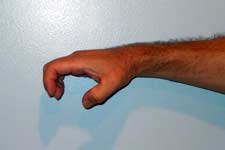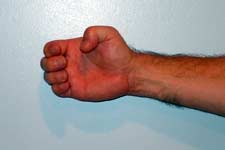 ... So there I was running along the grassy median, ostensibly to provide extra protection for my joints, when I stepped off the curb and... owww!
... So there I was running along the grassy median, ostensibly to provide extra protection for my joints, when I stepped off the curb and... owww! And being a True Warrior, the second thought to enter my mind--the first is unpublishable-- was " Damn! Rohai!".
Now, for all of you non-Shorin Ryu-people out there, Rohai is the name of a Tomari-te Shorin-ryu kata. Its name means something like "Vision of a Crane". You know. The kind with feathers.
The Crane is one of the Five Animals of Southern Chinese Kung Fu and Chinese Medicine. Okinawan karate is an amalgam of a native Okinawan fighting called "Te" and Kung Fu transmitted through forms or "katas" that arrived on the island from China via travelling merchants.
Anyway, the point is that the signature move of this kata is a pullback into a one-footed stance. What goes up must come down, so the foot we lift has to get back to the floor. For that, we have basically two choices: the smart way and the lazy way.
The smart way is to bend the knee of the supporting leg, loading it like a spring, and to gently place the foot down. The lazy way is to slam the foot down as quickly as possible and get on it.
Guess which way most of us do it.
Now guess how I injured my foot when I stepped off the curb.
Today's workout involved a bit of Passai and, needless to say, a lot of Rohai. I was pretty limited in turning and direction changes because of the pain in my left foot, but I figured it was worth it to do it slowly and reinforce doing things the smart way as opposed to the lazy way.
And then I noticed it. It had never occurred to me that all four times in the course of Rohai that we do that one-legged stance, we raise the right foot and use the left as the supporting leg-- which hurt, by the way, but that is not the point.
The point is that I can do Rohai from now until Tuesday and not learn to lower myself by bending my right leg so my left leg will land softly. That kind of learning doesn't cross from one side of the brain to the other. I either have to do a mirror version of Rohai that forces me to reverse my stances (as if I am aware of when I use my left and when I use my right) or find some other section of some other kata that helps me reinforce the right habit.
And that's one heck of a bad habit to tackle. As a right-footed runner, I have lived my entire life pushing off with my right and leading with my left. As a new runner, I haven't slammed down my left foot and caused myself nearly enough pain to have learned my lesson that way. Not yet, at least.
So what's the solution? Just unmitigated, unrelenting mindfulness? AGAIN?? Just sort of makes me want to bury my head in the sand... But that's a bird of a different feather...


